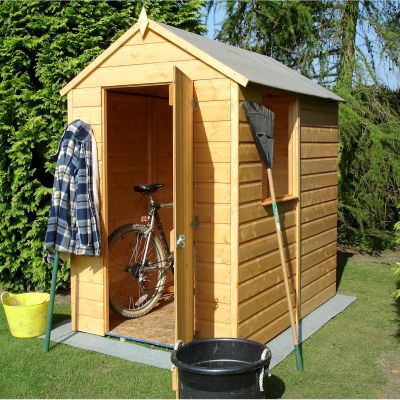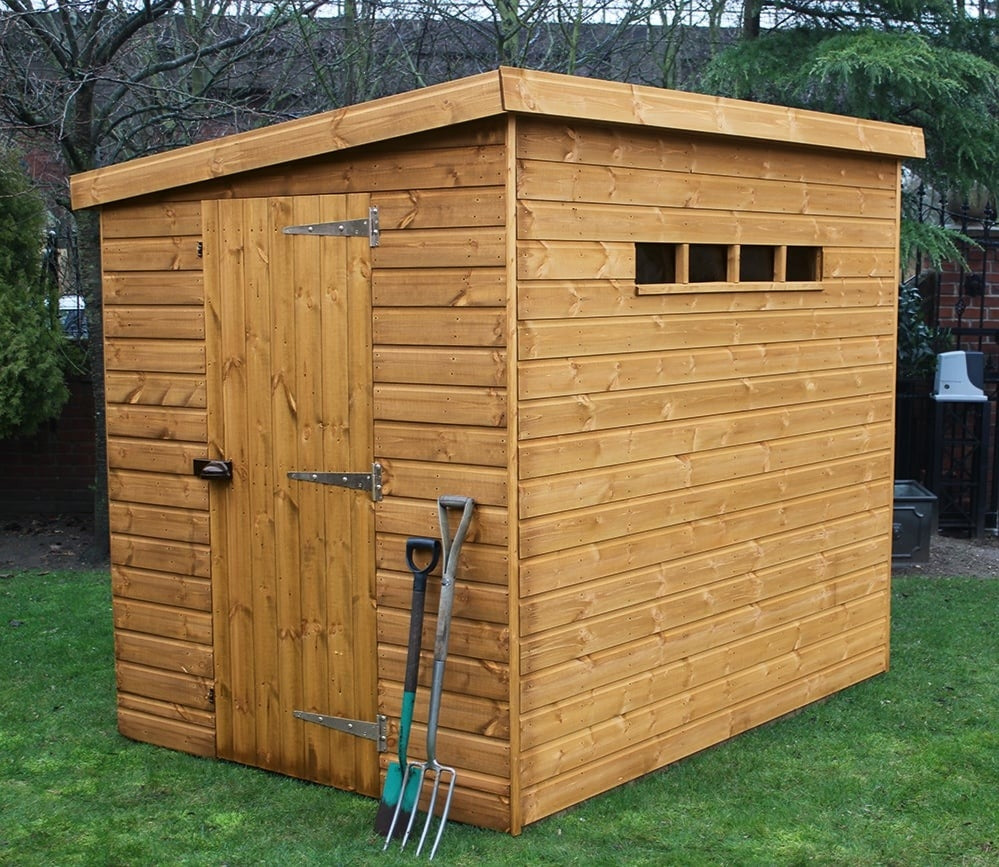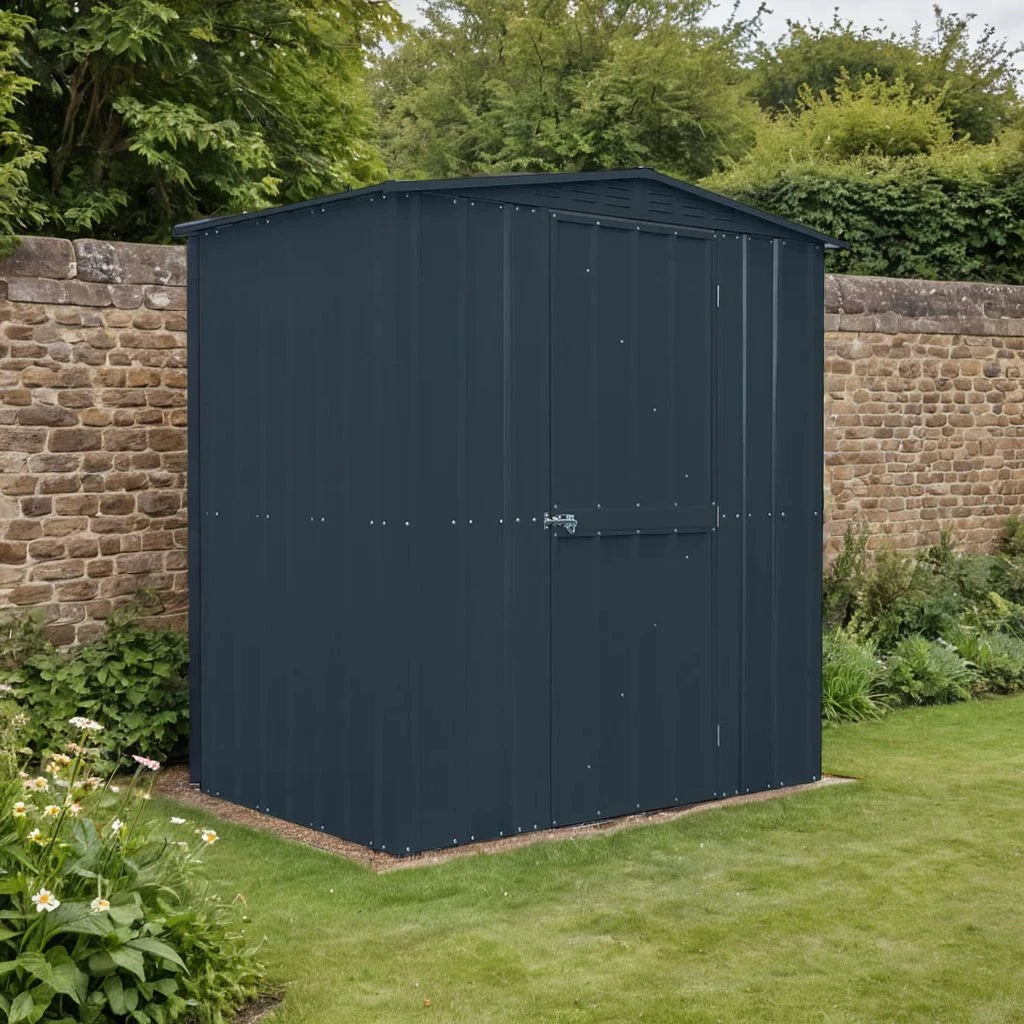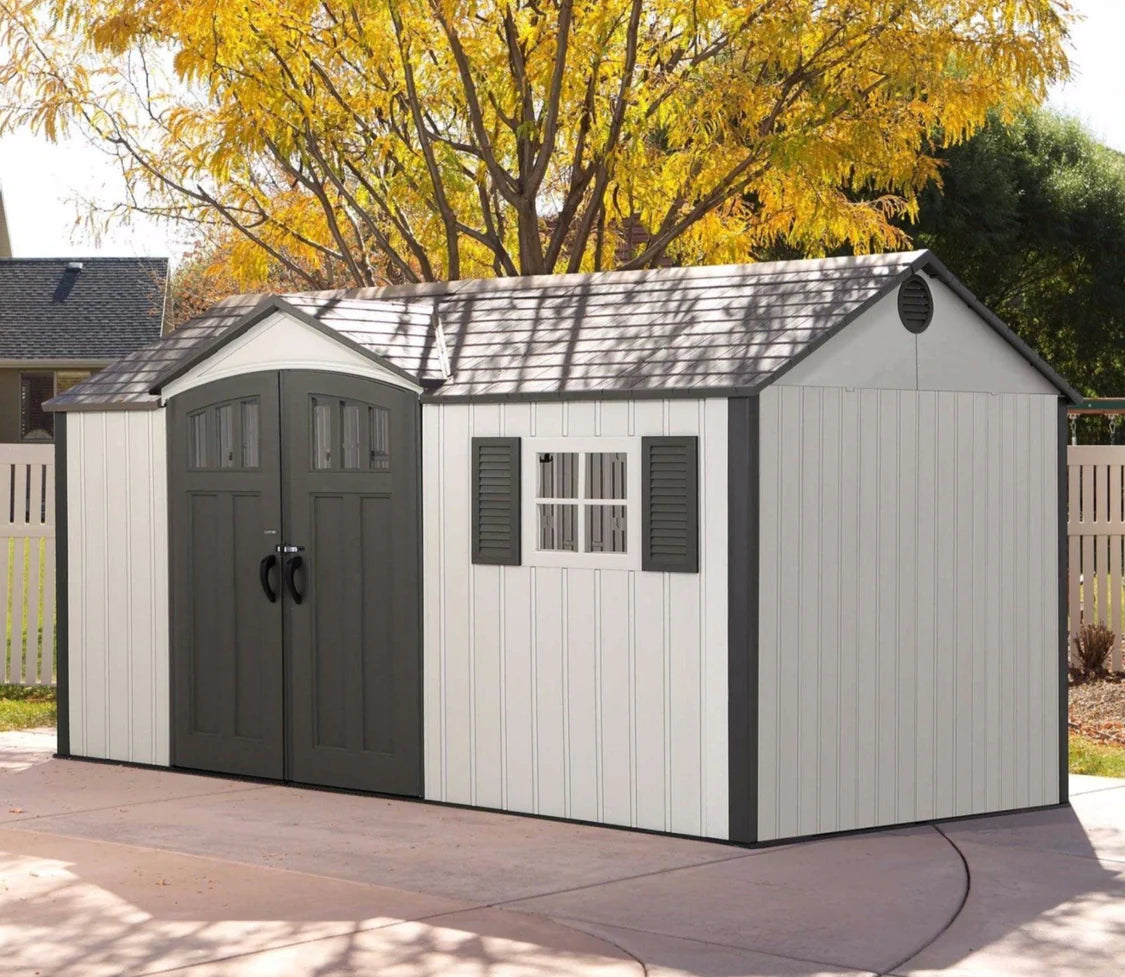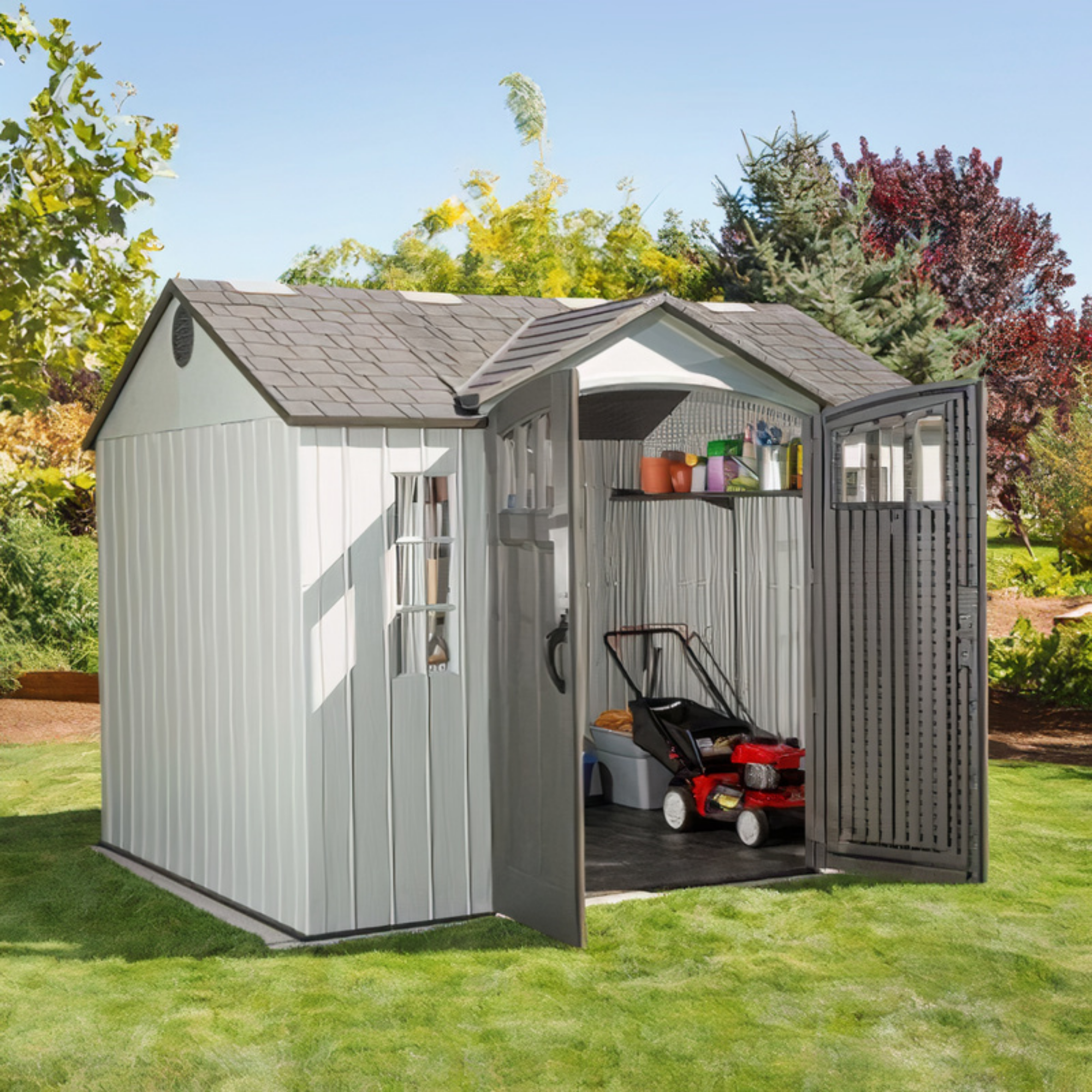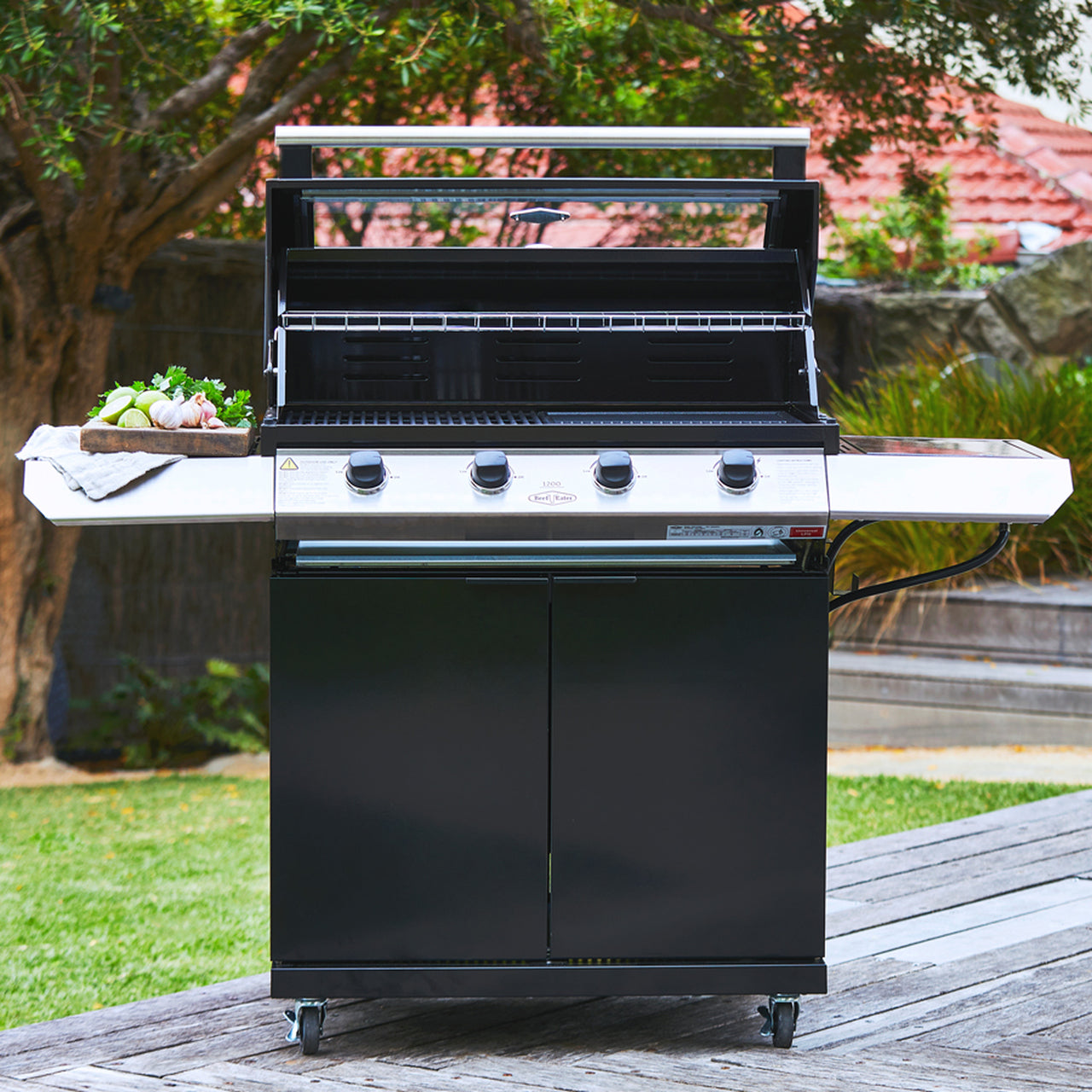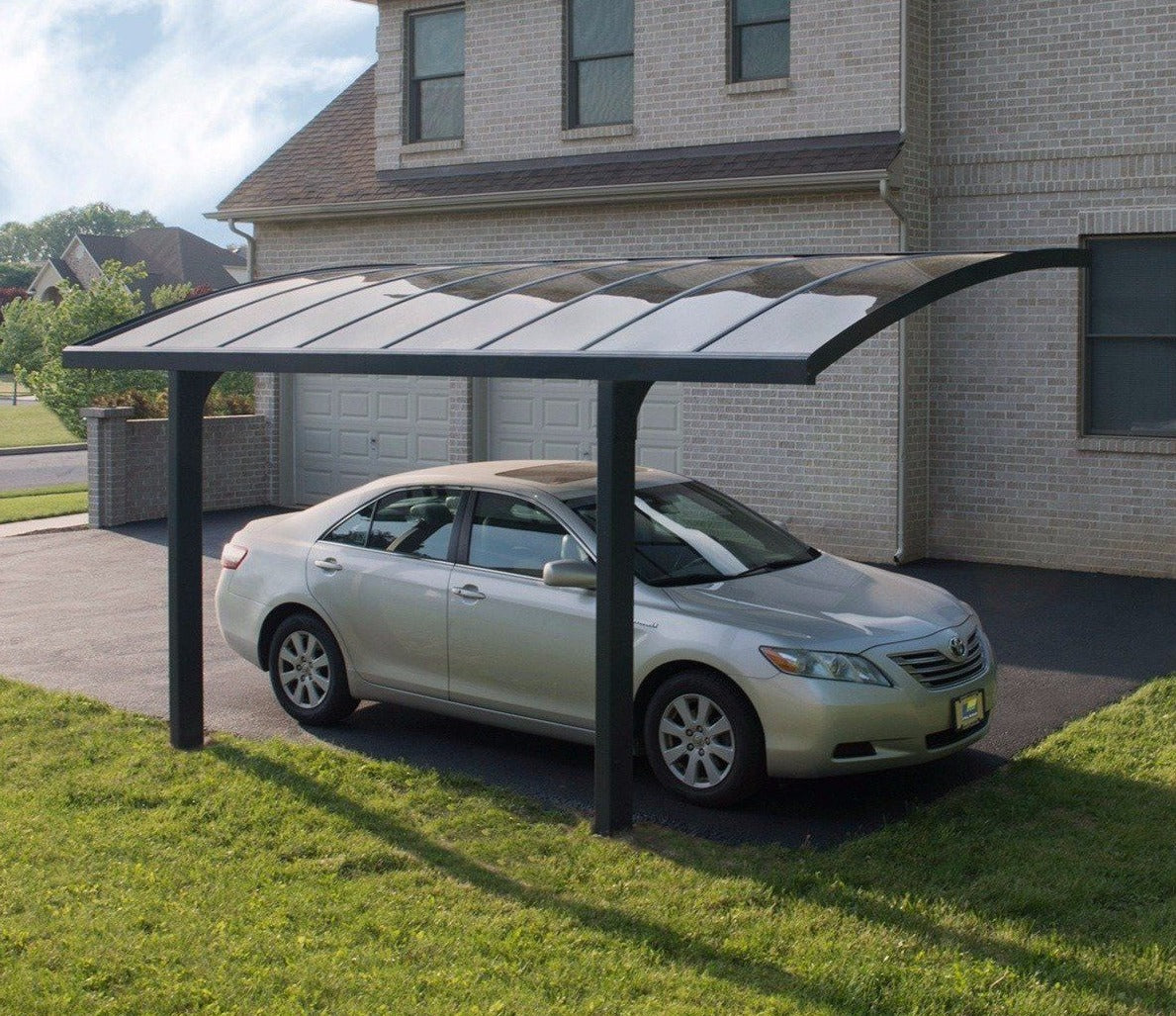10 Solid Wooden Garden Storage Ideas for Winter: Keep Your Garden Organised and Tidy

You know that feeling when November rolls around and suddenly your hallway's cluttered with muddy wellies, your expensive garden cushions are taking over the spare room, and those brand new secateurs you bought in spring are gathering rust under a dripping gutter? Yeah, we've all been there.
As winter approaches, most UK homeowners face the same frustrating challenge. Where on earth do you store everything? The logs for those cosy evenings by the fire, the garden furniture you invested in last summer, the tools that'll cost a fortune to replace if they get damaged, not to mention all those bits and pieces that somehow accumulate in outdoor spaces.
The good news is that proper wooden garden storage can solve all these headaches in one go. And honestly, it's not just about tucking things away out of sight. Quality wooden storage solutions actually add character to your garden, even during those grey, drizzly months when everything else looks a bit lifeless. There's something quite charming about well crafted timber structures dotted around your outdoor space, weathering naturally whilst keeping your belongings safe and dry.
In this guide, we're diving into practical wooden garden storage ideas for winter that'll help you reclaim your indoor space and protect your outdoor investments. From compact storage boxes perfect for tiny patios to heavy duty log stores that'll see you through the coldest months, we've covered solutions for every garden size and every storage challenge. Each option is built to handle British weather, which, let's be honest, can throw just about anything at us between October and March. Whether you've got a sprawling garden or a modest courtyard, you'll find something here that fits your needs and your budget.
Why Choose Wooden Garden Storage for Winter?
Natural Durability and Weather Resistance
Here's the thing about wooden outdoor storage: when it's done properly, it's absolutely brilliant for British winters. We're talking about pressure-treated timber that's been specially prepared to handle months of rain, frost, and whatever else our weather decides to throw at it.
Pressure treatment forces preservatives deep into the wood fibres, protecting against rot, fungal decay, and insect damage. Unlike untreated timber that might start deteriorating after a single damp season, properly treated wooden garden storage can last for decades. Many products come with 10 or 15-year anti-rot guarantees, which tells you everything you need to know about their longevity.
What's brilliant about FSC-certified timber is that you're getting sustainable materials from responsibly managed forests. So yeah, you're sorting out your storage problem whilst making an environmentally sound choice. Plus, timber breathes naturally, which means it doesn't trap condensation inside like some plastic or metal alternatives. That breathability is essential for keeping your stored items dry and preventing that musty smell that develops when moisture gets trapped.
Aesthetic Appeal Year-Round - Wood Just Looks Better!
Let's be honest, winter gardens can look a bit bleak. But wooden structures actually look better as they age. That silvery-grey patina that develops on weathered timber? It's gorgeous. It blends seamlessly with dormant plants, bare soil, and the muted tones of a British winter garden.
Unlike bright plastic storage that screams "I'm hiding something ugly," wooden garden storage becomes part of your garden's character. It complements stone pathways, brick walls, and the natural textures you've already got going on. Even when your flower beds are looking decidedly sorry for themselves, a well-placed timber shed or storage box adds structure and visual interest.
The rustic charm works year round too. In spring and summer, it provides a natural backdrop for flowering plants. In autumn and winter, it holds its own as a feature in its own right.
Versatility and Multi-Purpose Use
One of the best things about wooden garden storage is how adaptable it is. A log store in winter becomes a pot storage area in spring. A storage box protects cushions in November, then becomes extra seating during a rare sunny February afternoon.
You can customise wooden structures fairly easily too. Add hooks inside for hanging tools, fit shelving for better organisation, or attach trellis to the sides for climbing plants. Try doing that with a plastic bin.
The long-term investment value is solid as well. Quality wooden garden storage adds to your property's appeal and functionality. It's not the kind of thing that looks tatty after a couple of seasons, unlike cheaper alternatives that crack, fade, or fall apart.
10 Wooden Garden Storage Ideas to Transform Your Winter Garden
1. Heavy-Duty Log Stores: Essential for Winter Warmth
If you've got a wood burner or open fire, you'll already know that keeping logs dry is absolutely essential. Wet wood doesn't just burn poorly, it creates creosote build up in your chimney, produces less heat, and honestly, trying to get damp logs going on a cold evening is nobody's idea of fun.
A dedicated log store keeps your firewood properly ventilated whilst protecting it from rain and snow. The slatted design allows air to circulate freely, seasoning your logs and maintaining that low moisture content you need for efficient burning. No more soggy logs, no more bringing dirt and spiders into the house with every armful of wood, and no more stacking logs against your garden wall where they attract moisture from the ground.
2. Compact Storage Boxes: Perfect for Smaller Gardens
Not everyone's blessed with acres of garden space. If you're working with a modest patio, a small courtyard, or even just a balcony, you still need somewhere to store your outdoor bits and pieces. Compact storage boxes are absolute lifesavers for these situations.
They're brilliant for keeping garden cushions dry during winter months. Those outdoor cushions aren't cheap, and leaving them exposed to frost and rain will ruin them in no time. A good storage box also handles small tools, bags of compost, bird food, plant pots, kids' garden toys, and all those other items that somehow multiply when you're not looking.
3. Multi-Functional Storage Benches: Style Meets Practicality
There's something quite clever about furniture that does two jobs at once. Storage benches give you somewhere to sit whilst hiding away all the clutter that accumulates in gardens. It's particularly useful on patios where space is at a premium and every piece of furniture needs to earn its keep.
During winter, these benches are perfect for storing outdoor cushions, throws, and blankets that you might want on hand for those unexpectedly mild afternoons when you can actually sit outside with a coffee. They're also great for keeping children's outdoor toys organised and out of sight, or for storing gardening gloves, hand tools, and other bits you need regular access to.
4. Specialist Welly Boot Storage: Mudroom Solutions
Let's talk about wellington boots for a minute. If you live anywhere in Britain, you own at least one pair. Probably several. And if you've got kids or dogs, those wellies see heavy use throughout autumn and winter. The problem? They're absolutely filthy most of the time, and storing them indoors means tracking mud through the house.
Dedicated welly boot storage is one of those things that seems like a luxury until you have it, then you wonder how you ever managed without it. It keeps your boots organised, aired out, and ready to grab when you need them, without turning your hallway into a mud pit.
5. Tall Vertical Storage: Maximising Limited Space
If you're working with a narrow side passage, a small courtyard, or limited ground space, vertical storage makes absolute sense. Instead of sprawling outwards, it goes upwards, giving you substantial storage capacity without eating into your usable garden area.
Tall vertical units are particularly brilliant for storing long-handled tools like rakes, spades, hoes, and brooms. These are awkward to store horizontally and often end up leaning against walls where they're in the way and exposed to weather. A proper tall storage unit keeps them organised, protected, and easy to access.
6. Wall-Mounted Log Stores: Space-Saving Firewood Solutions
Not everyone has room for a large freestanding log store. If you've got limited garden space but still want to keep firewood handy, a wall-mounted option works brilliantly. These compact units fix directly to your house wall, garage, or shed, keeping logs off the ground and readily accessible.
The elevation is actually beneficial for log storage. Keeping firewood off the ground prevents moisture wicking up from soil and reduces the likelihood of insects and fungi taking hold. The proximity to your house also means you're not trudging to the bottom of the garden in howling wind and rain when you need to top up your log basket.
7. Tool Storage Sheds: Dedicated Garden Equipment Protection
Garden tools represent a significant investment. A quality spade, fork, hoe, and rake can easily set you back over £100. Add in pruning saws, loppers, hedge trimmers, and other specialist equipment, and you're looking at several hundred pounds worth of kit. Letting them rust and deteriorate over winter is just throwing money away.
A dedicated tool storage shed protects your equipment from the elements whilst keeping everything organised and accessible. No more hunting through cluttered garages for that one specific tool you need. Everything has its place, everything stays dry, and everything's ready to use when spring gardening starts in earnest.
8. Large Capacity Storage Boxes: Family-Sized Solutions
Ok, we love wooden garden storage, and this one, isn't wood. But, it has been designed with a wood look, and we like this one if you are on a budget and want to achieve a wooden style.
If you've got a busy family household with active garden use, standard storage boxes just don't cut it. You need proper capacity to handle multiple garden chair cushions, outdoor toys, sports equipment, and all the other paraphernalia that accumulates when you actually use your garden.
Large capacity storage boxes solve the problem of seasonal changeover too. All those summer cushions, throws, and outdoor accessories need somewhere to live during winter months. A spacious storage box keeps them protected, organised, and ready to bring out again when better weather returns.
9. Combination Log and Tool Storage: The Ultimate Winter Solution
Why buy two separate storage units when one well-designed combination unit can handle both jobs? For medium-sized gardens where you burn logs regularly and need decent tool storage, combination units make absolute sense. They're space-efficient, cost-effective, and keep all your winter essentials organised in one location.
The integrated approach also looks neater than having multiple separate storage structures dotted around your garden. One substantial, well-made unit creates a focal point and adds structure to your winter garden whilst handling all your practical storage needs.
10. Premium Log Storage Boxes: Stylish Patio Additions
Sometimes you want log storage that's not just functional but actually attractive. Log storage boxes sit neatly on patios, providing convenient access to firewood whilst doubling as decorative elements in your outdoor space.
These boxes are perfect for that small supply of logs you keep near your patio doors for easy access on cold evenings. You're not storing your entire winter supply here, but you are keeping a couple of days' worth of firewood convenient and dry, which makes feeding your wood burner far less of a chore.
How to Choose the Right Wooden Garden Storage for Your Winter Needs
Assess Your Storage Requirements
Before you buy any garden storage, take 10 minutes to actually list what you need to store. Walk around your garden and your house, noting everything that's currently cluttering hallways, sheds, or taking up space indoors that really should live outside.
Be honest about volumes too. If you burn wood regularly, you need proper log storage, not a token box that holds a week's supply. If you've got extensive tool collection, a small cupboard won't cut it. Underbuying storage just means you'll be back here in six months looking for something bigger.
Think about future needs as well. If you're planning to upgrade your garden furniture next spring, will your current storage handle the additional cushions? If you're considering getting a wood burner, what log storage will you need? It's often worth buying slightly larger capacity now rather than having to upgrade later.
Measure Your Available Space
This sounds obvious, but you'd be amazed how many people buy storage that doesn't quite fit where they intended. Measure your available space carefully, accounting for door swing if you're buying a shed or cupboard, and leaving access room around the unit.
Consider pathways too. That log store might fit perfectly against your fence, but if it blocks your usual route to the garden shed, you'll curse it every time you need to get past. Think about how you move around your garden and where storage units will and won't interfere with daily use.
Visual impact matters as well. A large storage unit positioned prominently might dominate a small garden in a way you hadn't anticipated. Sometimes splitting storage between two smaller units in different locations works better than one big shed.
Consider Your Budget and Long-Term Value
Quality wooden garden storage isn't the cheapest option upfront, but it often represents the best long-term value. A well-made timber shed with a 15-year anti-rot guarantee will outlast three or four cheap plastic alternatives that crack, fade, and fall apart.
Think about maintenance costs too. Pressure-treated timber requires minimal ongoing maintenance compared to untreated wood that needs annual treatment. FSC-certified products might cost slightly more initially but they're sustainably sourced and built to last.
Warranties and guarantees tell you a lot about product quality. Manufacturers offering 10 or 15-year guarantees are confident their products will last. Companies offering one or two years aren't.
Match Storage Type to Primary Use
Don't try to make a log store do the job of a tool shed, or vice versa. Specialist storage solutions are designed for specific purposes and they do those jobs better than general-purpose alternatives.
If your main need is protecting expensive garden furniture cushions, buy a proper storage box with a waterproof lid. If you need to store long-handled tools, get tall vertical storage with appropriate dimensions. If you burn wood regularly, invest in a dedicated log store with proper ventilation.
That said, multi-function solutions work brilliantly when they're properly designed for their dual purpose. Storage benches that genuinely work as seating whilst providing storage are excellent. Combination log and tool stores make sense for many gardens. Just make sure you're getting something that does both jobs well rather than neither particularly effectively.
Maintaining Your Wooden Garden Storage Through Winter
Pre-Winter Preparation
A bit of prep work in October or November pays dividends throughout winter. Check your timber storage units for any signs of damage or wear, and sort them out before the wet weather really sets in.
Inspect roof felt on sheds and storage boxes, replacing any sections that are lifting or damaged. Even small gaps let water in, which defeats the entire purpose of covered storage. Check that gutters and drainage channels are clear so water runs off properly rather than pooling anywhere.
If your wooden storage hasn't been treated recently, autumn is the ideal time to apply wood preserver or stain. The timber is usually fairly dry after summer, it absorbs treatment well, and you've still got decent weather for working outdoors. Most treatments need dry conditions for 24 to 48 hours to cure properly.
Ensure proper drainage around your storage units too. If water's pooling around the base after heavy rain, improve drainage or raise units slightly on gravel or paving slabs. Sitting in standing water is about the only thing that'll damage pressure treated timber long term.
Ongoing Winter Care
You don't need to fuss over quality wooden garden storage constantly, but occasional checks during winter prevent small issues becoming big problems.
After heavy snow, clear it off roofs before the weight becomes excessive. Most garden storage is built to handle normal snow loads, but a foot of wet snow is quite a different proposition.
Keep ventilation gaps clear. They're there for a reason, and blocking them with stored items or allowing leaves to accumulate defeats their purpose. Good airflow prevents condensation and keeps everything inside dry.
Check door seals and hinges periodically. A door that's slightly warped or hanging oddly lets water in. Catching these issues early means adjusting a hinge rather than dealing with water damage inside your storage.
Protecting What's Inside
Even the best wooden garden storage benefits from sensible organisation of contents. Don't cram things in so tightly that air can't circulate. Good airflow is essential for preventing damp and must.
For particularly valuable or sensitive items, consider additional protection. Cushions benefit from being stored in waterproof bags even inside covered storage, particularly during very wet winters. Tools can be lightly oiled to prevent rust, especially if you won't use them for months.
Keep rodents and insects out by ensuring doors close properly and there are no gaps large enough for mice to squeeze through. A mouse family setting up home in your garden storage over winter is nobody's idea of fun come spring.
Store heavier items on the bottom and lighter items higher up. This keeps the weight low for stability and prevents you crushing delicate items under bags of compost or pots of paint.
Garden Storage FAQs
What's the best wooden garden storage for winter?
The "best" storage really depends on what you're storing. For firewood, dedicated log stores with slatted sides provide the ventilation you need to keep logs properly seasoned. The Shire Pressure Treated models offer excellent weather protection with FSC-certified timber construction.
If you're protecting garden tools and equipment, look for enclosed sheds with felted roofs and ventilation gaps. Pressure-treated timber with anti-rot guarantees of 10 years or more indicates proper quality. For cushions and soft furnishings, storage boxes with solid lids and waterproof construction work brilliantly.
Honestly, the best approach is often combining different storage types. A log store for firewood, a tool shed for equipment, and a storage box for cushions covers most bases. But if you're only buying one unit, choose based on your primary storage challenge.
How do I keep my wooden garden storage dry in winter?
Proper placement is your first defence. Position storage units on level ground with good drainage, never in spots where water pools after rain. If possible, site them under partial shelter from house eaves or large trees, though not directly under dripping gutters.
Felted roofs provide excellent waterproofing when properly maintained. Check felt annually and replace damaged sections before winter. Most wooden storage includes roof felt, but upgrading to better quality felt improves protection.
Ventilation is just as important as waterproofing. Those gaps and vents aren't defects, they're design features that prevent condensation build-up inside. Blocking them actually makes dampness worse, not better. The combination of a waterproof roof and good ventilation keeps contents dry even during wet British winters.
Raising storage slightly off the ground on paving slabs or gravel improves drainage underneath and prevents moisture wicking up from soil into timber. Most quality units include floor sections, but ground preparation still matters.
Will wooden outdoor storage rot in British winters?
Not if it's properly pressure-treated. Quality timber products undergo treatment processes that force preservatives deep into the wood fibres, protecting against rot, fungal decay, and insect damage. This isn't a surface coating that wears off, it's protection that runs right through the timber.
Look for products with substantial anti-rot guarantees. Fifteen-year guarantees indicate timber that's been properly treated and will handle British weather long-term. One or two-year guarantees suggest lower quality treatment that might struggle in our damp climate.
FSC-approved Northern European pine, properly pressure-treated, is exceptionally durable. The timber naturally resists decay, and treatment enhances this considerably. Many wooden sheds and storage units last 20 or 30 years with minimal maintenance.
That said, even treated timber benefits from occasional re-treatment, particularly after five or 10 years. A coat of wood preserver every few years extends life even further and maintains appearance.
Can I use a garden storage box as a bench in winter?
Absolutely, if it's designed for dual purpose. Dedicated storage benches are built to support people sitting on them safely and comfortably. The Galaxy Wooden Garden Storage Box & Bench, for instance, is specifically designed as both seating and storage.
Regular storage boxes not marketed as benches might lack the structural reinforcement needed to safely support sitting weight, particularly when you're talking about multiple people. Check the manufacturer's specifications regarding weight capacity and intended use.
For boxes that are suitable for seating, they work brilliantly year-round. In winter, they provide somewhere to sit whilst you're putting on or taking off wellies, or a spot to perch whilst enjoying those rare sunny winter afternoons. The storage function protects cushions and throws that you can bring out when you want to sit comfortably despite cooler temperatures.
Just be sensible about weight limits and how many people pile on. Timber storage is durable, but it's not indestructible.
How much storage capacity do I need for winter garden storage?
This entirely depends on your household size, garden size, and how actively you use your outdoor space. A small household with a modest patio might manage perfectly with a couple of compact storage boxes. A family with a large garden, multiple seating areas, and serious tool collection needs considerably more capacity.
As a rough guide, a standard garden furniture set's cushions need around 200 to 300 litres of storage. Add another 100 to 200 litres for garden toys if you've got children. Tool storage depends on your collection, but figure on at least a small shed or large cupboard if you've got more than basic hand tools.
For log storage, calculate based on consumption. If you burn a wheelbarrow load of logs weekly through winter, you need storage for at least a month's supply to avoid constant replenishment. Larger log stores holding six weeks or two months' worth give you proper buffer capacity.
It's usually better to err slightly on the generous side with storage capacity. Running out of space means items end up stored badly, cluttering indoor areas, or left exposed to weather. Having a bit of extra capacity means everything has a proper home and stays protected.
Protecting Your Garden Investment This Winter with Wooden Storage Solutions
Getting your wooden garden storage sorted before winter properly sets in is one of those jobs that makes the next few months considerably more pleasant. No more muddy wellies in the hallway, no more rusty tools, no more cushions taking over your spare room. Everything has its place, everything's protected, and everything's easily accessible when you need it.
The beauty of quality wooden garden storage is that it's not just functional, it actually enhances your outdoor space. Even during those grey November days when your garden's looking decidedly lacklustre, well-made timber structures add character and structure. They weather beautifully, developing that lovely silvery patina that blends naturally with winter gardens.
Whether you're investing in a comprehensive log store to keep your home warm all winter, a dedicated tool shed to protect your equipment, or compact storage boxes for cushions and accessories, you're making a choice that'll serve you well for years to come. Pressure treated timber with proper anti-rot guarantees represents genuine long term value, outlasting cheaper alternatives many times over.
Take a proper look at what you need to store, measure your available space carefully, and choose storage solutions that match your specific requirements. Don't compromise on quality, particularly for items like log stores and tool sheds that'll see heavy use throughout winter and beyond. FSC-certified timber from reputable manufacturers gives you both sustainability and durability.
Winter doesn't have to mean cluttered gardens and storage chaos. With the right wooden garden storage in place, you can keep everything organised, protected, and ready to use. Come spring, when everyone else is replacing damaged tools and ruined cushions, your gear will be in perfect condition and ready for another season of garden enjoyment.
Check out our wooden garden storage solutions here!
















